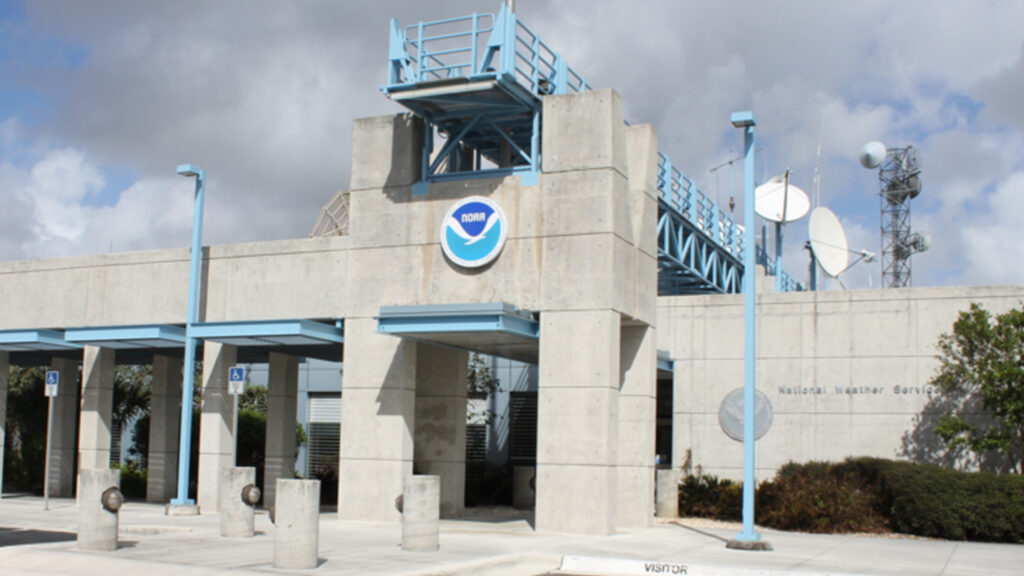By Louis Uccellini, Jack Hayes, D.L. Johnson, John J. Kelly Jr. and E.W. Friday
The proposed budget for fiscal year 2026, just released by the White House, cuts the National Oceanic and Atmospheric Administration (NOAA) by close to 30%. While details aren’t yet available, if earlier indications hold true this budget would essentially eliminate NOAA’s research functions for weather, slash funding for next generation satellite procurement and severely limit ocean data observations.
Even if the National Weather Service remains level funded, given the interconnectedness of all of the parts of NOAA, there will be impacts to weather forecasting as well. We cannot let this happen.
NOAA’s satellites provide vital information about the formation and pathways of storms. NOAA research on severe storms has paved the way for tools we now use every day, such as Doppler radar and storm modeling advancements. NOAA Corps pilots fly into hurricanes to bring us real-time information on these increasingly severe storms. And data from ocean buoys add breadth and depth to our understanding of the interaction between the atmosphere and the sea.

These proposed cuts come just days after approximately 300 National Weather Service (NWS) employees left the public service to which they had devoted their lives and careers. That’s on top of the approximately 250 NWS employees who were fired as a result of their probationary status in new – often higher-level – positions or took the initial buyout offered by the Trump administration in early February. That leaves the nation’s official weather forecasting entity at a significant deficit – down more than 10% of its staffing – just as we head into the busiest time for severe storm predictions like tornadoes and hurricanes.
NWS staff will have an impossible task to continue its current level of services. Some forecast offices will be so short-staffed that they may be forced to go to part-time services. Not only are there fewer forecasters, there are also fewer electronic technicians, who are responsible for maintaining the critical NEXRAD radars. Our worst nightmare is that weather forecast offices will be so understaffed that there will be needless loss of life. We know that’s a nightmare shared by those on the forecasting front lines — and by the people who depend on their efforts.
For example, airplanes can’t fly without weather observations and forecasts; ships crossing the oceans rely on storm forecasts to avoid the high seas; farmers rely on seasonal forecasts to plant and harvest their crops which feed us. Additionally, dam and reservoir operators rely on rainfall and snowfall forecasts to manage the water supply; fishermen in the $320 billion commercial fisheries sector rely on forecasts to stay safe as do tourism and recreational boating communities.
Perhaps most importantly, NWS issues all of the tornado warnings, hurricane warnings, flood warnings, extreme wildfire conditions and other information during extreme weather events. The dedicated staff at weather forecast offices around the country work 24/7/365 to make sure you get that information.
A word about these public servants. They aren’t nameless, faceless bureaucrats. They are your neighbors, your friends, the people who provide lifesaving information when you need it. They live and work in every community in the country. Their dedication to public service – and public safety – is unparalleled.
They will often sleep in weather forecast offices to make sure poor weather conditions don’t stop them from being on time for their shifts to do their critical work. They stay at their stations during hurricanes, tornadoes and other severe storms, even when extreme weather affects their own families. They make sure the complicated technology, like the radars we all see on television or on our apps, stay up and operating. They are the everyday heroes that often go unsung.
The NWS heroes who remain know that lives and livelihoods literally depend on the accuracy of weather forecasts as well as the prompt dissemination of that information to the people who need it. As former directors of the National Weather Service, we know firsthand what it takes to make accurate forecasts happen and we stand united against the loss of staff and resources at NWS and are deeply concerned about NOAA as a whole. Join us and raise your voice too.
Louis Uccellini, Ph.D., was NWS director from 2013-2022; Jack Hayes, Ph.D., was NWS director from 2007-2012; Brig. Gen. D.L. Johnson, USAF (Ret.), was NWS director from 2004-2007; Brig. Gen. John J. Kelly Jr., USAF (Ret.), was NWS director from 1998-2004; and Col. E.W. (Joe) Friday, Ph.D., USAF (Ret.), was NWS director from 1988-1997. Banner photo: An image captured on a NOAA satellite of Hurricane Milton approaching the Gulf Coast of Florida. (NOAA)
Sign up for The Invading Sea newsletter by visiting here. To support The Invading Sea, click here to make a donation. If you are interested in submitting an opinion piece to The Invading Sea, email Editor Nathan Crabbe at nc*****@*au.edu.




It appears that this administration is determined to severely curtail if not outright eliminate scientific offices, data collection, research, innovation, prognostication, etc. While our homes and communities flood and burn, the “leaders” dither about with meme coins and pie in the sky (Alcatraz) proposals meant to distract us from the damage they are inflicting upon all of us. Remember this as you prepare for the next election cycle.